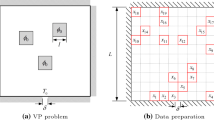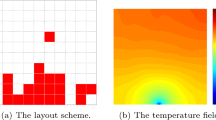Abstract
The thermal issue is of great importance during the layout design of heat source components in systems engineering, especially for high functional-density products. Thermal analysis requires complex simulation, which leads to an unaffordable computational burden to layout optimization as it iteratively evaluates different schemes. Surrogate modeling is an effective method for alleviating computation complexity. However, the temperature field prediction (TFP) with complex heat source layout (HSL) input is an ultra-high dimensional nonlinear regression problem, which brings great difficulty to traditional regression models. The deep neural network (DNN) regression method is a feasible way for its good approximation performance. However, it faces great challenges in data preparation for sample diversity and uniformity in the layout space with physical constraints and proper DNN model selection and training for good generality, which necessitates the efforts of layout designers and DNN experts. To advance this cross-domain research, this paper proposes a DNN-based HSL-TFP surrogate modeling task benchmark. With consideration for engineering applicability, sample generation, dataset evaluation, DNN model, and surrogate performance metrics are thoroughly investigated. Experiments are conducted with ten representative state-of-the-art DNN models. A detailed discussion on baseline results is provided, and future prospects are analyzed for DNN-based HSL-TFP tasks.
Similar content being viewed by others
References
A. I. J. Forrester, and A. J. Keane, Prog. Aerospace Sci. 45, 50 (2009).
M. Emam, S. Ookawara, and M. Ahmed, Renew. Energy 141, 322 (2019).
X. Chen, W. Yao, Y. Zhao, X. Chen, and X. Zheng, Struct. Multidiscip. Optim. 58, 2635 (2018).
A. Géczy, Int. J. Heat Mass Transfer 109, 167 (2017).
X. T. Cheng, X. H. Xu, and X. G. Liang, Sci. China Ser. E-Tech. Sci. 52, 2937 (2009).
A. Arshad, M. Jabbal, P. T. Sardari, M. A. Bashir, H. Faraji, and Y. Yan, Thermal Sci. Eng. Prog. 18, 100520 (2020).
K. Chen, S. Wang, and M. Song, Int. J. Heat Mass Transfer 93, 108 (2016).
D. Martínez-Maradiaga, A. Damonte, A. Manzo, J. H. K. Haertel, and K. Engelbrecht, Int. J. Heat Mass Transfer 142, 118429 (2019).
B. Song, and Z. Guo, Int. J. Heat Mass Transfer 54, 4531 (2011).
K. Chen, S. Wang, and M. Song, Int. J. Heat Mass Transfer 100, 737 (2016).
Y. Aslan, J. Puskely, and A. Yarovoy, Int. J. Heat Mass Transfer 122, 432 (2018).
T. J. R. Hughes, The Finite Element Method: Linear Static and Dynamic Finite Element Analysis (Dover Publications, New York, 2000).
Y. Gu, L. Wang, W. Chen, C. Zhang, and X. He, Int. J. Heat Mass Transfer 108, 721 (2017).
A. P. C. Cuco, F. L. de Sousa, and A. J. Silva Neto, Optim. Eng. 16, 165 (2015).
E. Monier-Vinard, V. Bissuel, B. Rogie, N. Laraqi, and O. Daniel, IEEE Trans. Compon. Packag. Manufact. Technol. 8, 1042 (2018).
J. P. Murcia, P. E. Réthoré, N. Dimitrov, A. Natarajan, J. D. Sørensen, P. Graf, and T. Kim, Renew. Energy 119, 910 (2018).
B. D. Lackey, M. Pürrer, A. Taracchini, and S. Marsat, Phys. Rev. D 100, 024002 (2019), arXiv: 1812.08643.
A. Ciccazzo, G. D. Pillo, and V. Latorre, Neural Comput. Applic. 24, 69 (2014).
X. Zhang, B. Yang, T. Yu, and L. Jiang, IEEE Trans. Energy Convers. 35, 966 (2020).
D. A. White, W. J. Arrighi, J. Kudo, and S. E. Watts, Comput. Methods Appl. Mech. Eng. 346, 1118 (2019).
Z. Xu, Y. Gao, X. Wang, X. Tao, and Q. Xu, in Surrogate thermal model for power electronic modules using artificial neural network: Proceedings of the IECON 2019—45th Annual Conference of the IEEE Industrial Electronics Society, Lisbon, Portugal, 14–17 October, 2019, pp. 3160–3165.
T. Goel, R. T. Haftka, W. Shyy, and N. V. Queipo, Struct. Multidiscip. Optim. 33, 199 (2007).
J. Zhang, S. Chowdhury, and A. Messac, Struct. Multidiscip. Optim. 46, 223 (2012).
W. Yang, R. T. Tan, J. Feng, J. Liu, Z. Guo, and S. Yan, in Deep joint rain detection and removal from a single image: Proceedings of the 2017 IEEE Conference on Computer Vision and Pattern Recognition, CVPR 2017, Honolulu, USA, 21–26 July, 2017, pp. 1685–1694.
D. Kang, X. Wang, X. Zheng, and Y. P. Zhao, Fuel 290, 120006 (2021).
Z. Gong, P. Zhong, Y. Yu, W. Hu, and S. Li, IEEE Trans. Geosci. Remote Sens. 57, 3599 (2019).
X. Chen, X. Chen, W. Zhou, J. Zhang, and W. Yao, Struct. Multidiscp. Optim. 62, 3127 (2020).
C. M. Bishop, Pattern Recognition and Machine Learning (Information Science and Statistics) (Springer-Verlag, Berlin, Heidelberg, 2006).
J. A. Bennell, K. A. Dowsland, and W. B. Dowsland, Comput. Operations Res. 28, 271 (2001).
N. Chernov, Y. Stoyan, and T. Romanova, Comput. Geometry 43, 535 (2010).
X. Chen, W. Yao, Y. Zhao, X. Chen, and W. Liu, Acta Astronaut. 180, 560 (2021).
V. Badrinarayanan, A. Kendall, and R. Cipolla, IEEE Trans. Pattern Anal. Mach. Intell. 39, 2481 (2017).
A. Krizhevsky, I. Sutskever, and G. E. Hinton, in Imagenet classification with deep convolutional neural networks: Proceedings of the 26th Advances in Neural Information Processing Systems 25, Lake Tahoe, USA, 3–6 December, 2012, pp. 1106–1114.
P. Ballester, and R. M. Araujo, in On the performance of googlenet and alexnet applied to sketches: Proceedings of the Thirtieth AAAI Conference on Artificial Intelligence (AAAI Press, Phoenix, 2016), pp. 1124–1128.
K. Simonyan, and A. Zisserman, arXiv: 1409.1556.
K. He, X. Zhang, S. Ren, and J. Sun, in Deep residual learning for image recognition: Proceedings of the 2016 IEEE Conference on Computer Vision and Pattern Recognition, Las Vegas, USA, 27–30 June, 2016, pp. 770–778.
C. Szegedy, W. Liu, Y. Jia, P. Sermanet, S. Reed, D. Anguelov, D. Erhan, V. Vanhoucke, and A. Rabinovich, in Going deeper with convolutions: Proceedings of the Conference on Computer Vision and Pattern Recognition, Boston, USA, 7–12 June, 2015, pp. 1–9.
G. Huang, Z. Liu, L. V. D. Maaten, and K. Q. Weinberger, in Densely connected convolutional networks: Proceedings of the Conference on Computer Vision and Pattern Recognition, Honolulu, USA, 21–26 July, 2017, pp. 2261–2269.
F. Visin, K. Kastner, K. Cho, M. Matteucci, A. Courville, and Y. Bengio, arXiv: 1505.00393.
E. Shelhamer, J. Long, and T. Darrell, IEEE Trans. Pattern Anal. Mach. Intell. 39, 640 (2017).
O. Ronneberger, P. Fischer, and T. Brox, in U-net: Convolutional networks for biomedical image segmentation: Proceedings of the 18th International Conference on Medical Image Computing and Computer-Assisted Intervention—MICCAI 2015, edited by N. Navab, J. Hornegger, W. Wells, and A. F. Frangi, Munich, Germany, 5–9 October, 2015, Vol. 9351 of Lecture Notes in Computer Science (Springer, Cham, 2015), pp. 234–241.
T.-Y. Lin, P. Dollár, R. Girshick, K. He, B. Hariharan, and S. Belongie, in Feature pyramid networks for object detection: Proceedings of the Conference on Computer Vision and Pattern Recognition, Honolulu, USA, 21–26 July, 2017, pp. 936–944.
S. Ioffe, and C. Szegedy, in Batch normalization: Accelerating deep network training by reducing internal covariate shift: Proceedings of the 32nd International Conference on Machine Learning, edited by F. R. Bach, and D. M. Blei, Lille, France, 6–11 July, 2015, pp. 448–456.
Y. Wu, and K. He, in Group normalization: Proceedings of the 15th European Conference on Computer Vision—ECCV 2018, edited by V. Ferrari, M. Hebert, C. Sminchisescu, and Y. Weiss, Munich, Germany, 8–14 September, 2018 (Springer, Cham, 2018), pp. 3–19.
A. S. Reimer, and A. F. Cheviakov, Comput. Phys. Commun. 184, 783 (2013).
S. Kokoska, and D. Zwillinger, CRC Standard Probability and Statistics Tables And Formulae (CRC Press, Boca Raton, 1999).
Author information
Authors and Affiliations
Corresponding author
Additional information
Note
The codes for reproducing this supervised DNN surrogate modeling benchmark are published at the project Web page: https://github.com/idrl-lab/supervised_layout_benchmark.
This work was supported by the National Natural Science Foundation of China (Grant Nos. 11725211, 52005505, and 62001502), and Postgraduate Scientific Research Innovation Project of Hunan Province (Grant No. CX20200023).
Rights and permissions
About this article
Cite this article
Chen, X., Zhao, X., Gong, Z. et al. A deep neural network surrogate modeling benchmark for temperature field prediction of heat source layout. Sci. China Phys. Mech. Astron. 64, 1 (2021). https://doi.org/10.1007/s11433-021-1755-6
Received:
Accepted:
Published:
DOI: https://doi.org/10.1007/s11433-021-1755-6
- temperature field prediction of heat source layout (HSL-TFP)
- heat source layout dataset (HSLD)
- deep neural network surrogates
- baseline methods
- benchmark




